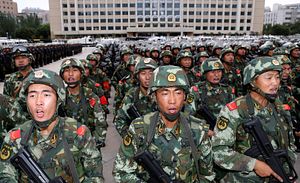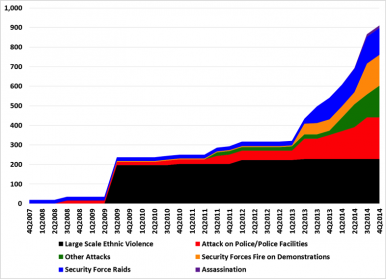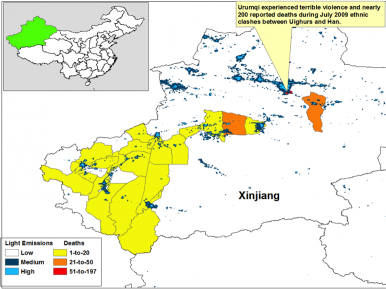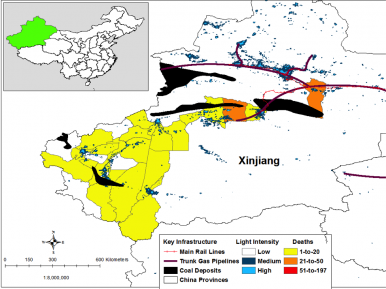China’s long-running Uighur insurgency has flared up dramatically of late, with more than 900 recorded deaths in the past seven years. This puts the conflict’s cumulative death toll in a range similar to that of The Troubles in Ireland or the ETA/Basque separatist violence in Spain. Russia’s longstanding conflicts in the Caucasus share elements with China’s Xinjiang troubles, and also show how harsh repression actually intensifies conflicts and encourages metastasis into other previously peaceful parts of the country.
Kinetic repression, restrictions on worship and religious attire, and a police state response alone will not placate the Uighurs in Xinjiang. The precise set of methods necessary to achieve peace is not yet clear. However, the consequences of failing to identify and employ a more holistic, less inflammatory set of policies to pacify Xinjiang are quite clear: continued violence in the province, as well as periodic substantial terror attacks elsewhere in China, such as the bloody Kunming train station attack of 1 March 2014.
Incident Data
The Chinese government’s security apparatus is striking hard in Xinjiang, with increasingly frequent kinetic police actions and nearly weekly announcements of long prison sentences and death sentences being handed down to suspected “separatists.” The frequency of violent incidents has risen sharply in the past 18 months, with security force actions, Uighur attacks on security forces and facilities, and insurgent attacks on railway stations and markets accounting for the bulk of the death toll since the first quarter of 2013 (Exhibit 1).
Exhibit 1: Xinjiang insurgency cumulative deaths by incident type, October 2007-to-31 December 2014
Quarterly basis
Source: Media Reports, Author’s Analysis
Before delving deeper into the data, a bit here regarding humanity, as well as sourcing of the data. First and foremost, the data points depicted in this analysis are not mere “statistics” Rather, each arises from tragedy befalling people with deep and complex human stories and we feel for the families of all who are deceased and injured in these incidents. Second, the data come from an extensive search of reputable Chinese and English language sources, including Xinhua, Xinjiang local sources, Reuters, RFA, and the New York Times. The dataset is useful, but limited, as it only captures what was reported, and thus likely under-reports the true death toll. It focuses on actual fatalities because they are a proxy for the seriousness of violence. Finally, the dataset seeks to focus on acts that are politically motivated, rather than simple run-of-the-mill criminality
So, what is driving the upswing in violence and what might these data points portend for Xinjiang’s future security environment? The surge in violence between Uighur demonstrators, insurgents, and Chinese security forces in Xinjiang suggests the conflict is entering a new phase in which deep Uighur frustration at repressive police and security practice is boiling over. Indeed, the fact that demonstrators equipped only with axes, farm implements, and crude home-made explosives are willing to attack security forces armed with automatic weapons suggests a profound degree of anger and desperation.
Lethal attacks on security forces and police facilities increased sharply in the summer of 2013 and have trended strongly upward since then. The deliberate and increasingly frequent (and bloody) targeting of security forces also serves as a warning sign that the Chinese government has overplayed its hand with respect to repression and has reached a tipping point where greater armed repression simply sparks more violence and makes security forces and facilities lightning rods, for they are viewed by many Uighurs as the hand that enforces and enables repressive policies.
Geographic Concentration of Xinjiang’s Violence
The worst documented outbreak of violence in at least the past 20 years occurred in Urumqi during July 2009, when nearly 200 people died and at least 1,700 reported injuries. Aside from the spasm of violence in Urumqi, the majority of violent incidents have occurred in the Uighur-centric population belt arcing through Western and Southwestern Xinjiang, in particular the area around the city of Kashgar (Exhibit 2).
Northern Xinjiang has been remarkably quiet, despite hosting reasonably large population centers (as reflected by the nighttime light emissions depicted in Exhibit 2). It is likely that the quiet in these area stems from the fact that these communities are newer and primarily populated by Han who have migrated to Xinjiang in order to staff various industrial enterprises and oil and natural resources development projects – for instance the large refinery and oil storage facilities at Dushanzi west of Urumqi.
Serious mass casualty incidents have also occurred in Urumqi (May 2014 market bombing), Luntai, and in the Turpan area southeast of Urumqi. This map only captures deaths in Xinjiang and does not reflect the Kunming Train Station attacks and other incidents perpetrated by insurgents elsewhere outside Xinjiang.
Exhibit 2: Known Deaths by County in Xinjiang, October 2007-to-31 December 2014
While making clear ethnic identifications is tough because of a lack of details in most media reports of incidents, Uighurs account for the overwhelming majority of deaths from security force actions, attacks on police and police facilities, and security forces firing on demonstrators. Deaths from “other attacks” and large-scale ethnic violence are primarily a mix of Uighurs and Han
Putting the Conflict in Perspective
The Xinjiang conflict could get much bloodier than it is today. Some Uighurs were captured fighting alongside the Taliban in Afghanistan and there are very likely a number of Uighurs in the ranks of ISIS/ISIL today. If they survive, they will be imbued with confidence, will have seen the benefits of accessing larger-scale financing, and will almost certainly receive encouragement to take their fight to other parts of China with a scale and intensity not yet seen. Our view at this point is that China’s competent and wide-reaching – if imperfect – surveillance apparatus will prevent a large-scale influx of Uighurs who have fought under the radical Islamic banner in the Middle East and Afghanistan/Pakistan. Foreign jihadist movements will serve primarily as cheerleaders, not quartermasters or providers of soldiers, for anti-Beijing elements in Xinjiang.
The threat will not be an existential one to the Chinese state, as most Uighurs would prefer a peaceful accommodation. But even if only 1 percent of Uighurs hold extreme views, there are 10 million in Xinjiang and even for a state security apparatus as formidable as China’s, 100,000 or more angry people present a tough challenge.
Even if the attacks are not an existential threat, they will be very difficult to anticipate and prevent. Recent attacks such as the Boston Marathon Bombing, Westgate Mall Attack in Kenya, and the Charlie Hebdo attack in France mark an emerging trend of low cost, easy to plan terrorist attacks that are exceedingly difficult to prevent. China has already experienced such attacks – for instance the Kunming Train Station attacks, Tiananmen Square attack, and the May 2014 attack on a farmer’s market in Urumqi – where common items like knives, gunpowder or fertilizer, and SUVs became lethal weapons. Just as important, such attacks do not kill thousands as 9-11 did, but they are immensely disruptive and can sow disproportionate fear in a society.
The nature of attacks in Xinjiang suggests that foreign terror actors may provide inspiration, but that the men and materials are all locally-sourced. The fact that the attacks use readily available local materials (vehicles, fertilizer, gunpowder, knives, axes) poses a real dilemma for Beijing because there is no apparent flow of weapons from abroad that can be interdicted.
To boot, unless the Chinese government prevents Uighurs from owning cars and common woodcutting and food preparation tools – which is unlikely – the means of attack are always present. Indeed, the possession of potential bombmaking materials like ammonium nitrate – a common fertilizer – has been seriously restricted since at least 2006 in Xinjiang.
On a tactical level, Xinjiang’s insurgency does offer China’s public (and private) security apparatus a number of tangible benefits. Xinjiang gives China’s security forces an internal, restricted access “beta lab” in which to test new techniques and technologies (such as drones) before the Chinese military potentially employs them beyond China’s borders.
The continuing conflict in Xinjiang is also creating a core group of police and paramilitary personnel with significant live fire experience in a hostile operational environment. These men (and increasingly, women) offer a prime talent pool for China’s new private security providers as they recruit staff to hire out to Chinese miners and construction firms operating in Africa and other areas where projects may require armed protection.
The growing insurgency in Xinjiang is imposing significant costs on the Chinese government, but the province’s rich mineral resources and strategic geographical position are too valuable to give up, even at the cost of a much bloodier conflict than that which exists today. One looming question is “will Uighur insurgents expand their campaign to include key energy, mining, and other critical infrastructure in Xinjiang?” Such a move is conceivable, but most of these assets lie in open desert and basin and range-type geography that is easily kept under surveillance by unmanned aerial vehicles and other means.
Moreover, destroying infrastructure takes more capability than attacking a train station or market. Firearms, explosives, or heavy tools such as welding and cutting equipment are essential if one hopes to break open a pipeline, destroy rail lines, damage power transformers, or topple power transmission pylons. Such implements are difficult to get ahold of in Xinjiang – for unlike the Middle East and other parts of Central Asia – civilian access to firearms and explosives is tightly restricted and attempts to obtain such items on the black market risks exposing plotters to law enforcement. The other possibility is that Uighur insurgents or their supporters abroad could launch cyber attacks on critical infrastructure or other assets in China. To date, we locate no mention of such attacks and it appears this threat dimension has not yet manifested itself.
The Uighur-dominated areas such as Kashgar where much of the violence has occurred lately are strategically located, but the primary infrastructure arteries (gas pipelines) and mineral resources (coal and oil fields) lie either far out in the virtually uninhabited Taklamakan Desert or sit well north of the “Uighur belt” of Southern and Southwest Xinjiang (Exhibit 3).
Exhibit 3: Xinjiang Violence and Proximity to Key Mineral Resources and Key Rail and Pipeline Infrastructure
Bottom Line
Forbidding Uighurs’ religious worship is also clearly not a solution, as Beijing and its local agents cannot excise belief from the minds of the faithful. If anything, harsh repression of religion simply empowers the most radical elements who are willing to openly confront the Chinese government – creating exactly the turmoil Beijing seeks to avoid. China is clearly in control of Xinjiang. If Beijing employed more tolerant policies that recognized Uighurs’ religious and economic needs and expressed confidence in its hold on the region, this loosening would very likely have the counter-intuitive effect of defusing tensions, reducing violence, and making both Uighurs and Han better off. “Strike hard” programs are not the answer and will only catalyze additional violence.
Gabe Collins is the co-founder of China SignPost and a former commodity investment analyst and research fellow in the US Naval War College’s Maritime Studies Institute.




































